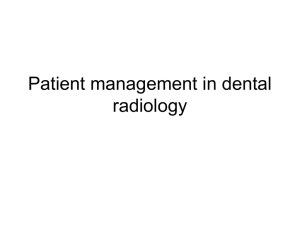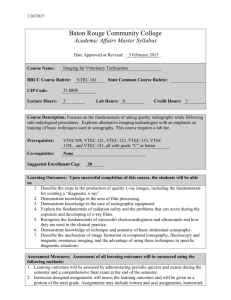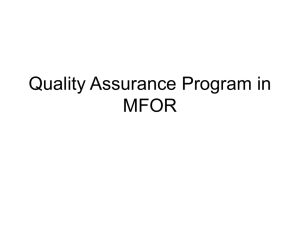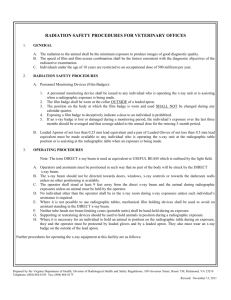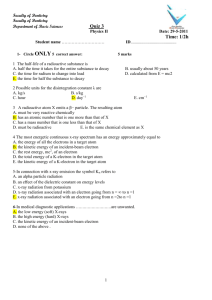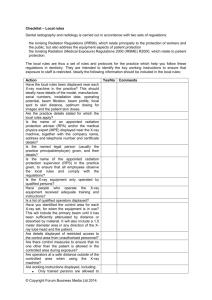1) RADIATION SAFETY OFFICER
advertisement
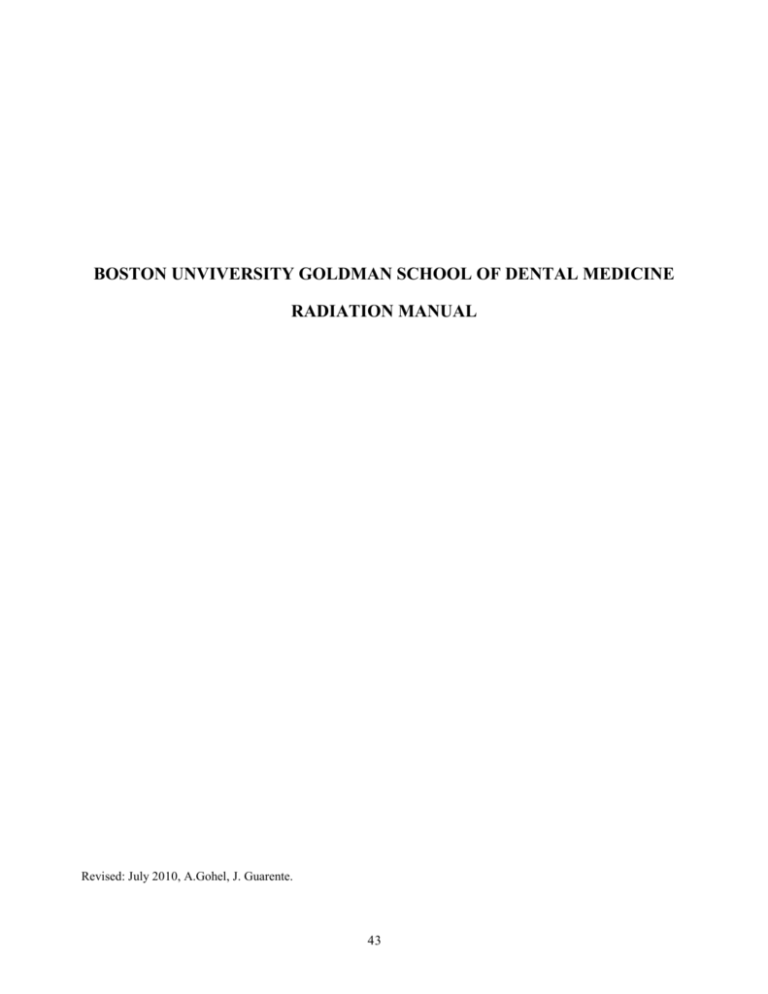
BOSTON UNVIVERSITY GOLDMAN SCHOOL OF DENTAL MEDICINE RADIATION MANUAL Revised: July 2010, A.Gohel, J. Guarente. 43 1) RADIATION SAFETY OFFICER The School appoints the radiation safety officer for all diagnostic radiation sources at the clinics under Boston University Goldman School of Dental Medicine's jurisdiction, including those in the main facility and at the 930 Commonwealth Avenue practice. The responsibilities of the Radiation Safety Officer include A. Establishing, implementing, and monitoring guidelines and policies on radiographic practices B. Approving any purchases and remodeling of radiographic facilities. C. Monitoring performance levels of x-ray units. D. Monitoring radiation safety procedures. E. Investigating reported or suspected incidents of misuse or hazards of radiation equipment. F. Implementing quality assurance programs. G. Maintaining records for each x-ray unit inspection. H. Educating all new staff to the radiation policies including technique, safety practices, prescribing procedures, and state and federal radiation rules and regulations. I. Providing periodic continuing education programs for all staff operating x-ray generating and processing equipment. J. Working in association with the x-ray safety committee at Boston University Medical Center. 2) CLINICIAN Only dentists, dental hygienists, certified dental assistants, other personnel who are certified, and students who have completed sufficient training on manikins are permitted to make patient exposures. A. Dentists employed by BUGSDM as faculty, clinicians, or in the postdoctoral programs are authorized to operate X-ray equipment. B. Registered dental hygienists employed in the various clinics are authorized to operate X-ray equipment. C. Dental assistants must be certified to operate the radiographic equipment. D. Surgical assistants are required to be certified to operate X-ray equipment. E. Any other staff must also complete a radiology certification program to operate any X-ray equipment. didactic course which includes radiation safety and F. Dental students must complete the Radiology Preclinical Laboratory training to a satisfactory level before being allowed to make X-ray exposures on patients. Faculty supervision is required. G. Courses that use X-ray equipment by students lacking certification must be supervised by a member of BUGSDM faculty. 3) PREGNANCY A. Any X-ray operator who is pregnant may voluntarily declare her pregnancy and the estimated date of conception in writing to the Radiation Safety Officer. Thereafter, her occupational radiation exposure shall be limited to 0.5 mSv per month related to the stochastic effects of radiation) as required by the NRC (National Regulatory Commission.) B. It is the responsibility of the operator to decide whether the risks to her or to a known or potential unborn child are acceptable. 4) STAFF AND FACULTY TRAINING A. Periodic training sessions are provided for all personnel using x-ray equipment. B. Radiation safety sessions are required of all new personnel and post-doctoral residents who may be using x-ray equipment. C. Auxiliary staffs are also required to meet the requirements of DANB or other professional organizations as they may apply. 43 I 5) EXPOSURE CRITERIA A. All radiographs are prescribed in writing by a BUGSDM faculty member who is a dentist or by a postdoctoral resident. B. All prescriptions are made after determining the patient’s need by reviewing the medical and dental history and by performing a clinical exam. The selection criteria follow those recommended in the enclosed chart developed by representatives of various dental and federal agencies. C. SELECTION CRITERIA D. If prior radiographs are available, they are obtained and evaluated prior to taking new radiographs. E. Radiographs are made only on patients who are capable of complying with the procedure. F. No radiographs are taken on a routine basis. G. Radiographs may be taken for research purposes with institutional review board approval. H. Radiographs solely for teaching, training, insurance, or other administrative purposes are not permitted. I. Radiographs are not taken solely for dental board examination purposes. J. Students must become proficient in intra-oral techniques on mannequins prior to exposing patients. K. Retakes are taken after evaluating the initial film, which does not meet diagnostic criteria, and after determining the technical error. Supervision of faculty to aid in the correction of the error is required. L. All radiographic interpretations are noted in the patient’s chart. M. For pregnant patients, the school will follow the recommendations of the Dental Radiographic Selection Criteria Panel set by theADA and US Department of Health and Human Services (2004). The amount of scattered radiation striking the patient’s abdomen during a properly conducted radiographic examination is negligible. However, there is some evidence that radiation exposure to the thyroid during pregnancy is associated with low birth weight .Protective thyroid collars substantially reduce radiation exposure to thethyroid during dental radiographic procedures. Because every precaution should be taken to minimize radiation exposure, protective thyroid collars and aprons should be used whenever possible. This practice is strongly recommended for children, women of childbearing age and pregnant women. 7) SAFETY PROCEDURES A. All patients are draped with lead aprons and, where the technique allows, thyroid collars. B. Digital sensors are used for all intra-oral radiographic exposures. If films have to be used, F- speed films should be used for all intra-oral exposures. C. No person other than the patient is allowed to be in the X-ray operatory during the exposure. If assistance is required, non-occupationally exposed persons (preferably a member of the patient’s family) will be asked to assist and will be draped with a separate apron. D. Extra-oral exposures employ digital or screen-film combinations of the highest speed consistent with their diagnostic purpose. As a rule, this implies use of rare earth screens and T-grain film. E. The operator stands behind adequate barriers when exposing a film. The door to the operatory must be closed. F. When a mobile X-ray unit is used or when no barriers are present, the operator is required to stand 6 feet and 90 to 135 degrees from the patient. G. Film holding devices, particularly the Rinn equipment, is used to avoid the patient holding it with a finger. H. Proper processing procedures to obtain quality radiographs Operator Safety A. Achieve Certification and Continuing Education B. Install Adequate Barriers: Lead Lined Walls, Leaded Windows, Adequately Thick Cement or Brick Walls Movable Lead Barriers C. Obey the Position and Distance Rule: 6 Feet from the Patient 90º - 135º to the Central Beam Patient Safety 43 A. B. C. D. E. F. G. ALARA: As Low As Reasonably Achievable Take Films by Prescription: Only When Necessary Use Digital sensors or Fast-Speed Film Use Proper Processing Procedures and Adhere to Quality Assurance Measures Place Lead Apron and Thyroid Collar on Every Patient Have Adequate Filtration in the x-ray tubes Use proper Collimation 8) RADIATION MONITORING A. Monitoring of all personnel who are involved in radiographic procedures is available. Badges are to be worn during working hours. Those who do not wish to have a badge are to sign a waiver form. B. Records of monthly and total cumulative exposures will be kept as a permanent record and is available for inspection. C. Employees should not receive more than 50 mSv (5 rem) each year, the radiation protection guide value. Any quarterly readings above 10 % of the radiation protection guide or 5 mSv will be investigated. D. Operators who are pregnant will be provided with an additional fetal badge and will not be exposed to more than 5 mSv during the duration of their pregnancy. 9) PATIENT RECORDS A. Radiographic Permission a. All radiographic examinations are authorized by Boston University faculty who are dentists. These prescriptions are dated and made after a complete review of the medical and dental history and a clinical exam. b. The amount of radiation to which the patient is exposed is recorded. This includes the exposure time, the kVp, and the mA. c. An initial interpretation of the radiographs is noted. B. Treatment Record a. The clinician records the date of exposure, the type and number of films taken, any retakes which are exposed and the reason, and any difficulties which occurred during this procedure b. Signatures by both the student and the faculty are documented. C. Radiographs a. All radiographs are mounted and labeled with the patient's name and date. b. The right and left side is noted on panoramic, other extra-oral films, and on duplicates. c. The images are stored on the server. d. Patients who request their radiographs are provided with a printed copy or a CD. 10) PHYSICAL FACILITIES AND EQUIPMENT A. Boston University School of Dental Medicine is in full compliance with state and federal laws pertaining to radiation safety including NCRP. B. All operatories with x-ray equipment have adequate barriers for the operator. This may include lead lining of the walls and doors or a portable lead barrier in areas where the doors do not close or are not present. All have a 43 transparent panel to permit a safe view of the patient during exposure. C. The x-ray beam is collimated to not more than 2.75 inches when striking the face. When circular collimators are used for intra-oral films, the beam diameter at the patient's face is restricted to 2.75 inches. Rectangular collimators limit the beam to 2.0 inches at the face on the long side. D. Shielded open-end cylinders are used with paralleling technique. E. The target-to-skin distance for intra-oral radiography is not less than 8 inches. When practical, a long positionindicating device of 12 inches or over is used. F. X-ray machines contain a minimum total filtration consistent with Federal and State regulations: 1.5 mm of aluminum equivalent to 70 kVp and 2.5 mm aluminum equivalent for equipment operating above 70 kVp. G. Exposure control switches are the deadman type and is positioned behind the barrier. All radiation emission terminates after the preset time of exposure. When possible, the x-ray unit has both an audible and a visual indicator to signal exposure termination. H. All machines shall have appropriate exposure parameters posted near the control panel. I. Radiographic viewing is accomplished with equipment such as dim background lighting where possible, masked viewboxes, opaque mounts, and magnifying glass. J. Information regarding each x-ray unit and processor, its installation date, and all repairs re maintained by the Repair Department. Calibration reports are kept in the Radiology Department. 11) LEAD APRONS A. Lead aprons are hung upon hooks and are discarded after a maximum of five years of use. The date when the apron is first put into circulation is marked on the lower corner. B. Lead aprons are hung up between use in each operatory with an x-ray machine. They are not folded. 12) QUALITY ASSURANCE Records are maintained and filed in the Radiology Department with the following information: A. Periodic calibrations of x-ray tube output. B. Dates and actions to correct any fluctuations of the x-ray equipment output. C. Exposure at the end of the PID tests. D. Description of the room housing the x-ray unit. E. Results of safety surveys F. Massachusetts Department of Public Health inspection certifications. 13) INFECTION CONTROL AND SAFETY A. Proper infection control protocol should be followed during radiographic procedures. All patients are treated as potentially infectious. B. Proper personal protection equipment is worn including gloves, masks, and lab coats. C. Proper hand washing procedures are adhered to before and after patient contact. D. All equipment is sterilized between patients. E. The operatory is appropriately covered with headrest co vers, tubehead covers, and tape. 43
